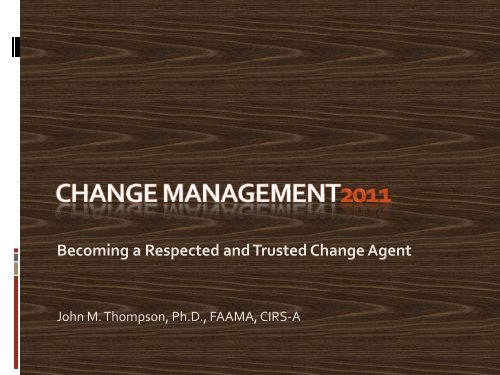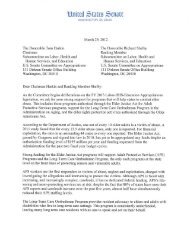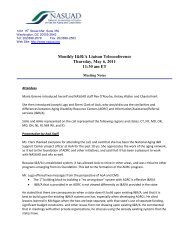Change Management Presentation
Change Management Presentation
Change Management Presentation
You also want an ePaper? Increase the reach of your titles
YUMPU automatically turns print PDFs into web optimized ePapers that Google loves.
Warm‐Up ExerciseWhat are your personal thoughts and feelingswhen you hear the following words?• Organizational change• Right sizing the organization• Systems change• Leadership change
<strong>Change</strong>• To transform the form, nature, content, orfuture direction of something. Example: new manager, organizational namechange, and new standard operatingprocedures• Inevitable
<strong>Change</strong> (cont.)• <strong>Change</strong> often involves a loss. For example,we will begin using a new system, whichmeans learning a new process and doingaway with the old. So, we must assistpeople with navigating the “loss curve.”• Uncomfortable• Psychological, social, and financial impacts
Why <strong>Change</strong>?• There are a plethora of reasons whychange occurs in an organization.• Some change efforts are bigger than otherones, but regardless, it can impact staffsdifferently.
Examples of Organizational <strong>Change</strong>• Leadership comes up with grandiose ideas that could improve thestrategic positioning of the organization, resulting in change.• New managers have a desire to prove themselves so theyimplement change.• New technology• Response to a Strengths, Weaknesses, Opportunities, and Threats(SWOT) analysis or job task analysis/job reengineering project• Poorly performing organization• Business development driven change
Common Responses to <strong>Change</strong>• Why do we have to change?• If it isn’t broke, don’t fix it.• Who does he think he is?• I’m putting my foot down!• How will this impact me?• She’s trying to make a name for herself.
On the Brighter Side of <strong>Change</strong>(Common Responses)• I’ve been waiting for this opportunity!• Why didn’t we do this a long time ago?• About time!
Perceptions to <strong>Change</strong>• Resistance to change is one’s reaction whenhe/she perceives that a change poses a threatto him/her.• A change has to be substantial enough topose a threat to someone.• As leaders and managers, we must bemindful that one’s perception is his/herreality. Thus, don’t minimize theirperceptions or feelings.
Warm‐Up ExerciseDiscuss the following two questions with yourgroup members.• Are you a change agent?• What constitutes an effective changeagent?
<strong>Change</strong>"It’s not so much that we are afraid of change, orso much in love with the old ways, but it’s theplace in between we fear... it’s like being inbetween trapezes... there’s nothing to hold onto."‐ Marilyn Ferguson
Point of Reflection:Coping with The Unknown• When change was imposed upon you, howdid you react?• As leaders and managers, how do youassist your staffs with adjusting toorganizational change?
<strong>Change</strong> <strong>Management</strong>Roles and Responsibilities• Leaders and managers must be champions ofall change initiatives.• Consider the following prior to embarkingupon organizational change. People are diverse and they behave differentlywhen faced with change. Some people thrive offof change as a change agent while others fear it.
<strong>Change</strong> <strong>Management</strong>Roles and Responsibilities (cont.) Meet everyone’s basic needs. Keep them inthe loop! Involve them in the decision makingprocess. Realistically manage people’s expectations.
Employees’ Responsibilityin <strong>Change</strong> <strong>Management</strong>• No responsibility to manage change.• Employees should only be expected to dotheir jobs according to their job descriptions.• Leaders/managers should craft the “OtherDuties As Assigned” for employees who willbe involved in organizational change.
Kurt Lewin’sThree Stages of <strong>Change</strong> *• Unfreeze• Transition• Refreeze* To guarantee success, leaders and managersmust follow each step sequentially.
Stage 1: Unfreeze• People are comfortable with theirsurroundings• Feel a sense of control• Feel a sense of complacency• People are unfrozen to take the next step inthe change process
Stage 1: Action Steps• Each step below must be successfullycompleted prior to advancing to the nextstep.• “Test the water” / Justification for change /Increase urgency Get your “If it isn’t broke, don’t fix it” colleagueson board. Face the realities of their emotions.
Stage 1: Action Steps (cont.)• “Test the water” / Justification for change /Increase urgency Open and honest communication Include staffs in all phases of the change effort–get them to shape how the change will lookwithin the organization; empower them! Get your informal leaders on board Realistic expectations
Stage 1: Action Steps (cont.)• “Test the water” / Justification for change / IncreaseurgencyConsequences of changing and consequences of notchangingProvide sufficient time for colleagues to express theirperspectives about the changeDetermine the reasons for staffs’ perspectives and addressthem• Some perspectives may be irrational and invalid, but theirperceptions are truly their reality.• The failure to address their concerns can be like cancer spreadingthrough the organization.• If concerns are valid, address and incorporate solutions.Communication strategy –get buy in
Stage 2: Transition• Coaching, mentoring, and trainingpeople through the chasm of change• Accepting the change
Stage 3: Freeze• Solidify the change that just took place• Incorporate the change into the cultureof the organization• Reflect on the change process
Stage 3: Action Steps• Burning Bridges –don’t provide the doubters anyway back Examples:• Name change: remove all old stationery from the file; onlymake new stationery available for print• Database change: transfer all data to new system and disallowlogin privileges to old database• Reward Realignment – establish reward systembased on personnel accomplishments related tothe change• Evidence Display –show stakeholdersquantitatively and qualitatively how change isbeneficial to the organization
Stage 3: Action Steps (cont.)• Institutionalization – incorporate the change intothe formal structure and culture of theorganization• Hold their feet to the fire –ensure that jobdescriptions are tied to the change and have staffssign verifying that they have been informed of themodified job description• Reminder – continuously remind staffs of theirnew role/responsibility as a result of the change
Action Items for theEntire <strong>Change</strong> Process• Throughout the entire process, be sure thatyou address the following: Providing effective and routine communication Persistence spirit Cheerleader Coach Take time to celebrate all accomplishmentsleading to the ultimate goal Conduct frequent climate checks
The Continuum of <strong>Change</strong>Stability Neutral <strong>Change</strong>“If it isn’t broken,don’t fix it.”“Ok with somechange, but don’tgo over board”“We should havedone this a longtime ago!”Level ofComplacencyWhere are you on the spectrum? How do you react to change?
Reactions Toward <strong>Change</strong>•Fear•Anger•Joy•Sadness•Trust/Distrust•Disgust•Surprise•Stress•Insecurity•Anticipation•Mixed emotions•Resistance to change•Loss of rationaljudgment•Negative attitudestowards the changeagent, leadership, andmanagement
One’s Experience with <strong>Change</strong>/Loss• Elisabeth Kübler‐Ross’s 1969 Grief Cyclemodel that was first published in On Death &Dying can be applied to organizationalchange.
One’s Experience with <strong>Change</strong>/Loss(cont.)• Shock –initial response to the “bad news”• Denial – attempting to avoid the inevitable• Anger –outward expression of frustration andbitterness• Rejection – refusing to buy into the inevitable• Bargaining – seeking for a way out• Depression – final reflection of the inevitable• Testing – determining how to adapt to thechange• Acceptance/Healing – moving forward
Loss Curve
Pitfalls to EffectiveOrganizational <strong>Change</strong>• Failure to have senior management sponsorship• Assigning the project to managers with verylittle seniority• <strong>Change</strong> agents working in silo• Moving too fast for the staff• Failure to get feedback of those who will beimpacted by the change (Theory X/authoritativeleaders)• Moving too quickly in implementing change
Pitfalls to EffectiveOrganizational <strong>Change</strong> (cont.)• Disregarding people’s emotions• Failure to adequately prepare for change• Lack of a coherent plan• Chaotic change rather than controlledchange• Leaders and managers attempt to imposechange on staffs• Lack of training
Points to Consider• CHANGE IS GOOD!• YOUR APPROACH TO CHANGE CANMAKE YOU OR BREAK YOU!
Participant Activity• Identify one change project in your workarea• Rationale for change (justification)• Develop your approach for rolling out thechange• Other teams will determine whether theproposed change plan sounds like asuccessful one to roll out.
Key Elements to Success• Host listening forums to involve impactedstaffs in the decision making process• Empower staffs• Avoid silos• Transparency• Avoid forcing change upon people• Open communication• Open door policy• Build trust
Key Elements to Success (cont.)• Take time to listen• Develop measurable and realistic goals• Remove (as far as is possible) barriers such asautocratic management approach and folks withnegative perspectives from the change process.• Involve your training department and externalconsultants who can assist in preparing staffs forthe change• Establish and maintain an organizational culturethat embraces change• Treat people the way they want to be treated
Develop Your<strong>Change</strong> <strong>Management</strong> Plan• Take a moment to think about a potentialchange management activity in your office.What is your overall plan for approaching it?• What are you most concerned about?• How will you get staff on board?• What are some factors that will ensure yoursuccess on this change management project?• What quality measures will you incorporateto periodically examine employee andorganizational outcomes?• How will you sustain the planned change?
Take Home Points• Focus on the Emotions because the failureto do so could lead to negative employee,operational, and financial outcomes forthe organization.• Justification for change.• Apply the functions of management toimplementing organizational change.• Stay calm.
Resources• Johnson, S. & Blanchard, K. (1998). Who movedmy cheese? New York, NY: Penguin Putnam.• Kotter, J.P. (1995). Leading change. Boston, MA:Harvard Business School Press.• Kotter, J.P. & Cohen, D. (2002). The heart ofchange. Boston, MA: Harvard Business SchoolPress.• Kotter, J.P., Rathgeber, H., Mueller, P., &Johnson, S. (2006). Our iceberg is melting:Changing and succeeding under any conditions.Boston, MA: Harvard Business School Press.• www.kotterinternational.com
Q&A















